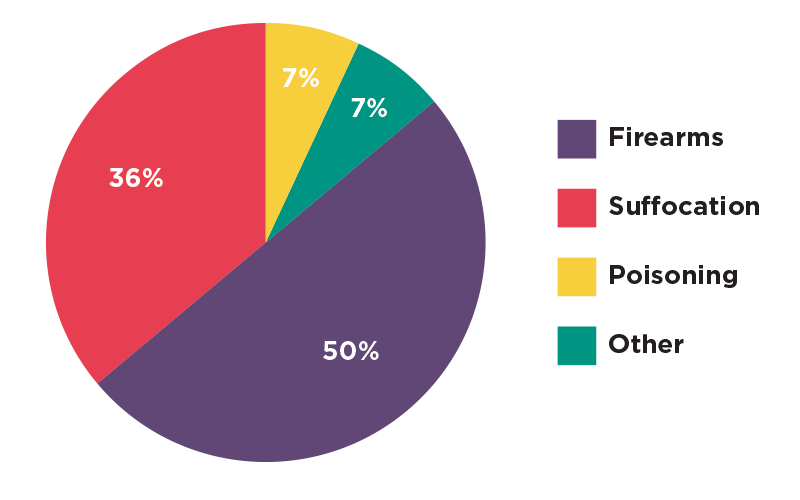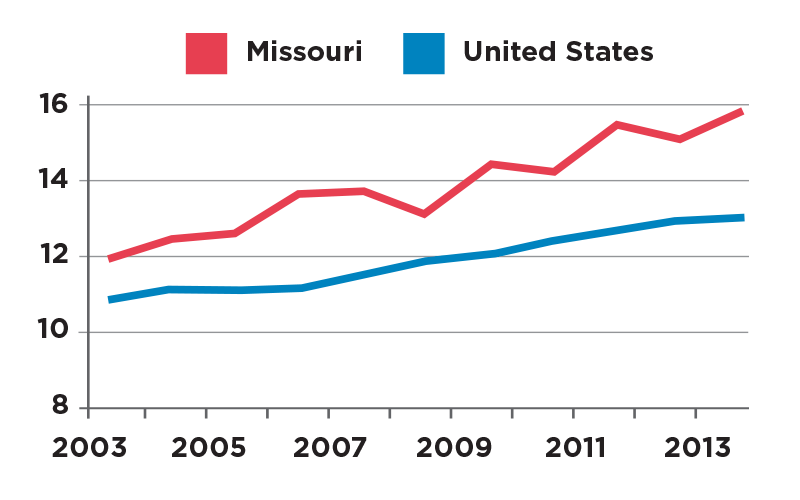Scope
National Data
- Suicide is the second leading cause of death among 15-34 year olds.
- For every person who dies by suicide, more than 30 others attempt suicide.
- Among undergraduates and graduates from 2012, 7.1-7.7% of students seriously considered suicide, 2.3% made a plan, and .6-1.2% attempted suicide. The rates for individuals of the same age but not enrolled in college full time are all 1-2% higher.
Missouri Data
- The means by which individuals take their lives varies depending on their age and sex, but the use of firearms is the primary means of suicide among Missouri both youth and adults.
- From 2010 to 2013, half of all suicides among youth 15-24 were due to firearms, followed by suffocation and poisoning. However, younger youth (10-14) are more likely to use suffocation.
- More Missourians died by suicide than by motor vehicle accidents (958 vs. 757).
Missouri Youth Ages 15-24 (2010-2013)

Missouri and U.S. Suicide Rates (2003-2013, per 100,000)

Risk and Protective Factors
Risk factors are characteristics that make it more likely that individuals will consider, attempt or die by suicide.
Risk Factors
- Previous suicide attempts
- Mental Disorders, particularly depression, anxiety disorders, posttraumatic stress disorder, schizophrenia and certain personality disorders
- Alcohol or other substance use disorders
- Family history of mental disorder or substance use disorder
- History of trauma, abuse or sexual assault
- Family history of suicide or exposure to others that have died by suicide
- Family violence
- Chronic physical illness, including chronic pain
- Firearms in the home or access to other lethal means
- Lack of social support or social isolation
- Major life adjustment
- Incarceration
- Perfectionism
Protective Factors
The risk of suicide can be lowered by certain protective factors. They include:
- Having a support system (family, friends, and school)
- Spiritual Beliefs or participation in a religious community
- Good self-care and positive thinking
- Communication, planning, and problem-solving skills
- An ability to manage strong emotions
- Access to mental health care and willingness to accept help
- A school environment that encourages help seeking and promotes health
- Other environmental protections, such as reducing access to firearms and other lethal weapons
Warning Signs
Warning signs indicate an immediate possibility of suicide, whereas risk factors indicate someone has an increased likelihood for suicide, but indicate little or nothing about immediate danger.
- Starting or increasing use of alcohol or drugs
- Aggressive, impulsive, reckless or disruptive behavior
- Talking about death and dying, expressing a strong wish to die or talking about wanting “pain” to end
- Preoccupation with death
- Planning a suicide
- Giving away belongings, tying up loose ends, saying goodbye to friends and family
- Purchasing a firearm
- Obtaining other means of killing oneself
Population Considerations
- Nearly 50% of U.S. military veteran college students reported considering suicide, and 20% reported currently having suicidal thoughts and a plan.5 An estimated 22 veterans die by suicide every day.
- People who have experienced rape or sexual assault are 13 times more likely to attempt suicide than non-victims.
- Lesbian, gay, bisexual, transgender, and questioning students are 3-4 times more likely to attempt suicide when compared to non-LGBTQ+ students.
- Young adult American Indians and Alaskan Natives have higher rates of suicide deaths than young adults of any other ethnicity.
- Asian-American students were more likely to have suicidal thoughts when compared with non-Asian-Americans.
- Inside the African-American community, those ages 18-24 are most likely to think about and to attempt suicide.
- Latino/a students are less likely to die by suicide, but those who were born in the U.S. report high levels of depression, suicidal thoughts, and attempts.
- Overall, the completion rate for suicide is higher in men, especially European American/White men. This is because this group chooses more lethal means.
- -Scope
